Article's Content
The cloud computing market is projected to hit a $1.5-trillion valuation by 2030. Naturally, the heavyweights like AWS, Microsoft Azure, and Google Cloud make up a large chunk of that sum, but there are plenty of lean startups and SMEs looking to eat up market share by leveraging product-led growth. And for good reason.
“Cloud computing” is no longer an esoteric term for techies to understand, it’s a foundational component of our everyday reality. From enabling digitally native companies to upholding efficiency in the energy sector, this technology helps both our digital and physical worlds go ‘round.
Our eyes are now open to the immense complexity and costs behind simple day-to-day tasks like checking email, posting on LinkedIn, and streaming that new Netflix show.
Here’s the National Institute of Standards and Technology’s (NIST) 2011 model of the interactions between different cloud layers and stakeholders:
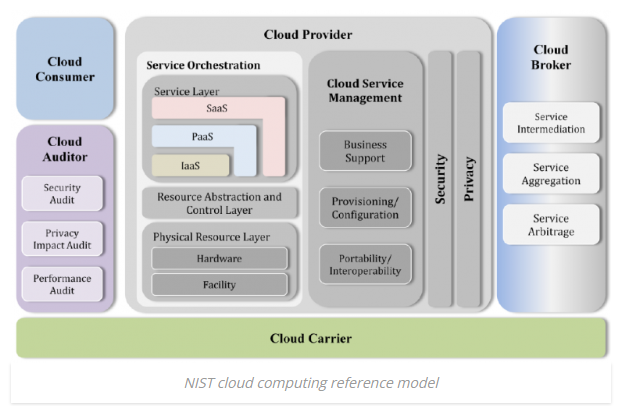
Source: NIST Cloud Computing Reference Architecture
Underneath our online experiences are massive digital structures that are designed, built, maintained, and secured by the blue-collar workers of the 21st century. We used to just call them “programmers.” But rapid cloud adoption is accelerating our understanding of the professions that make up the modern-day IT team. There are many heroes of cloud computing: developers, IT operations, networkers, and security.
Each of these technical specialists corresponds to a layer of the larger cloud computing industry (forgive my simplistic reduction):
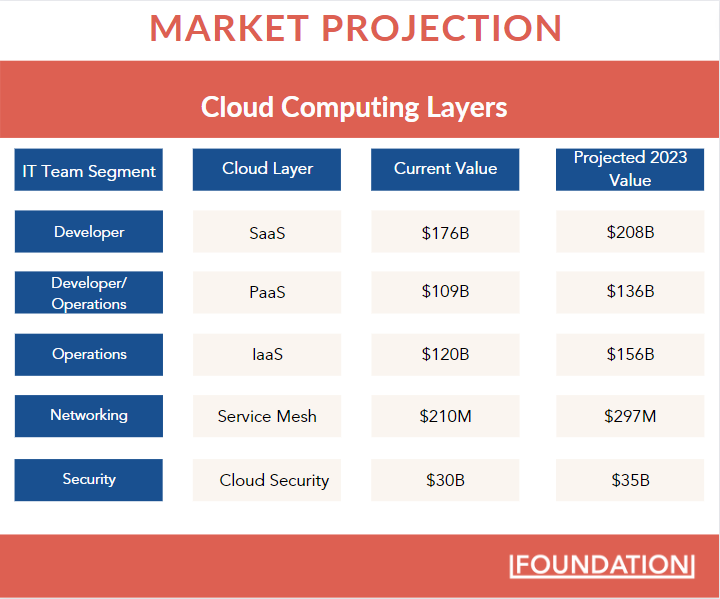
Source: Gartner (April 2022)
Each role is critical to maintaining the seamless online experiences we all expect and often take for granted. With more and more companies adopting the cloud model, their reliance on different cloud carriers and vendors will continue to grow, as will the complexity of maintaining service delivery across these different providers.
This is where B2B SaaS companies targeting the lower layers of cloud computing are poised for some serious growth—provided their products and services are top-notch.
HashiCorp, “a generation-defining infrastructure software company,” was born out of this critical shift towards cloud computing and offers a suite of products and managed services to help IT professionals at each layer.
Remember that convoluted image above, the one created by the NIST? Well, here’s how HashiCorp thinks it should look for 21st-century enterprise:

Source: Q4 FY22 Corporate Overview
This multi-product strategy of creating a consistent cloud foundation has launched them to a successful IPO in December 2022, is driving their $5.6-billion valuation, and helps them bring in some high-value customers like Lufthansa, AstraZeneca, Ubisoft, and thousands more.
One look at their Q4 highlights from fiscal year 2022 tells you all you need to know about their product-led strategy:
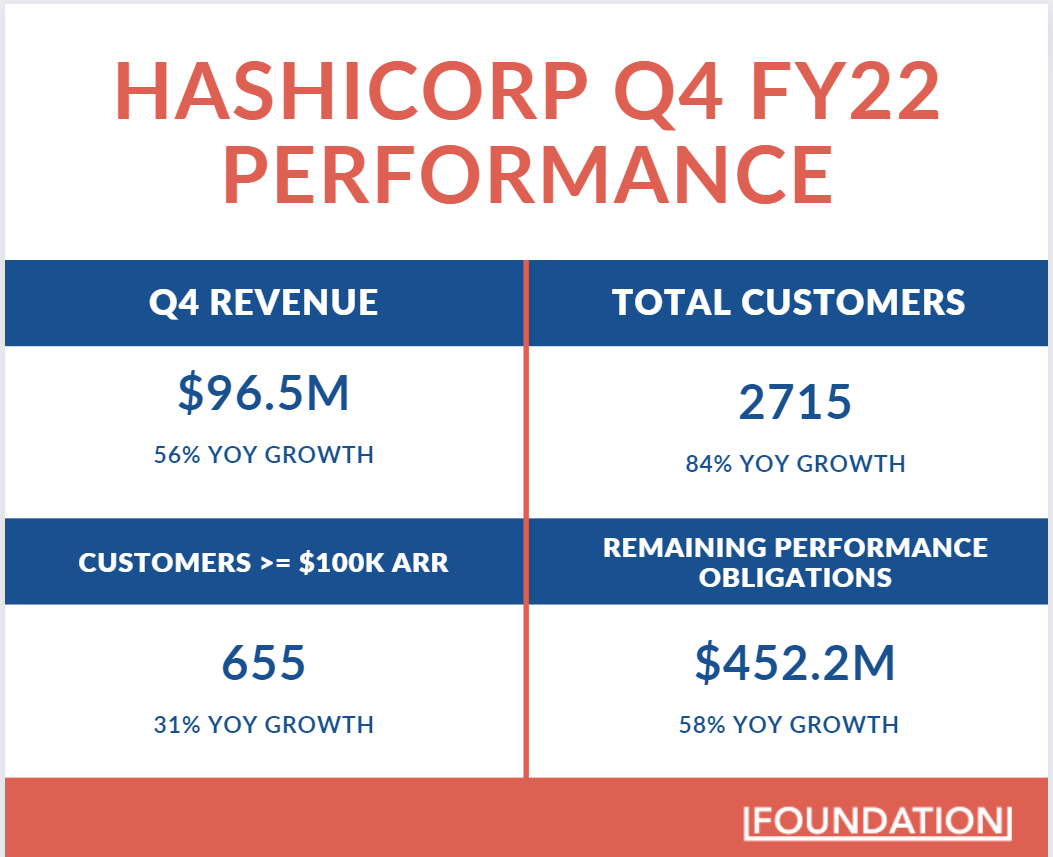
Lots of digital ink is spilled on the topic of generating growth through the product-led approach. It’s a topic that can still ruffle some feathers in marketing and sales departments, but the validation is strong.
In this essay, we’ll go over how marketers fit into the overall product-led growth approach and how B2B SaaS companies, particularly those like HashiCorp in the cloud computing space, can use it to their advantage.
Let’s get started.
Open Source is Key to Product-Led Growth
The product-led growth model is no secret. It’s as effective as it is popular, particularly in the B2B SaaS market. SaaS players like Figma, Slack, Notion, and countless others have used it as a growth catalyst.
It allows startups and growing companies to focus on the singular pursuit of developing the ultimate digital tool while circumventing growth-related issues like:
- The ever-increasing cost of paid advertising
- A preference for self-education among B2B consumers
- Direct product experience as part of the buying process
All stages of the customer journey—acquisition, expansion, conversion, and retention—are driven by the product itself. Not just sales or marketing.
There’s company-wide alignment on delivering the best user experience possible. That means sales, marketing, product engineering, product design, and customer success all channel their efforts into creating a product that provides an unparalleled UX. Product development puts all departments on the same wavelength in terms of the end goal.
The perfect analogy for this growth model comes in the form of this image from the experts at the Product-Led Growth Collective:
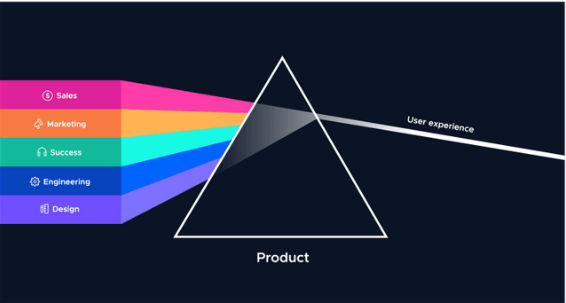
Image source: https://www.productled.org/foundations/what-is-product-led-growth#Chap1
It’s not about everyone deferring to the product team. It’s about each department making an equal contribution to creating the best possible user experience.
Here’s a breakdown of the process and how marketing fits into the picture:
1. Deploy all departments to ensure the product is perfect for the end user’s needs—not wowing the purchaser.
Marketers: Put on your research cap and do a comprehensive deep dive into your ICP (P.S. It’s about more than just social media scouring).
2. Offer up this highly effective, free product to users (not buyers).
Marketers: Be direct about the immediate value of the product and structure pages to reduce friction.
3. Users become “activated” by the product, and become key drivers for “viral” growth by spreading the word through social channels.
Marketers: Find out where people are talking organically about your product, look for opportunities to build community, and leverage social proof.
4. Additional features are layered on top of the free model, compelling users to purchase as their needs grow (often with minimal need for sales).
Marketers: Work with the product and sales team to determine the best positioning for extending and expanding users into paid offerings.
To the end-user, the product itself handles everything from onboarding to extension. But all departments are actively involved—their efforts are just rolled directly to the product for the initial growth stage.
By prioritizing the end user’s experience over everything, product-led flips the old gatekeeper model on its head. Top-down growth strategies rely on authoritative implementation and provide inconsistent growth. Bottom-up approaches rely on social proof and provide sustained growth.
The IT pros we touched on in the first section are key for this growth strategy, particularly for cloud-native products. If the developer, operations, networking, or security pros like the product, they can convince admins, managers, and executives to investigate paid options.
Companies providing open-source products typically apply one of three methods to get users and their teams/enterprises into the revenue stream:
- Limit feature access
- Limit capacity/storage
- Limit access to support
This is one area where HashiCorp differs from the conventional. They know that developers and enterprise teams hate having functionality limited. Instead, they opt to limit scale (but more on that later).
This growth model has been proven time and again across different SaaS verticals, but the explosive growth occurring in the cloud space gives this strategy an outsized impact, particularly for companies with the capability to expand across the four key user segments of cloud: developers, operators, security, and networkers.
Case in point: HashiCorp’s multi-product long-term growth engine.
Divide and Conquer: The Journey from Open Source to Commercial Scale
We’ve previously talked about how MongoDB successfully battled cloud giants like AWS, Azure, and Google Cloud through their singular focus on building the best NoSQL Database. They drilled down on their core product and are the vanguard of cloud data storage as a result.
HashiCorp takes the opposite approach, dividing up the cloud computing market to conquer IT departments, SMEs, and Global 2000 enterprises piece by piece.
The first step in this conquest begins with three open-source products. After HashiCorp wins individual cloud professionals with these core products, they can land enterprise teams and entire organizations with their other open-source products. Ultimately, this all culminates in adoption of the HashiCorp Cloud Platform — a managed service covering all layers of the cloud.
Here’s a high-level overview of their open source to commercial scale strategy:
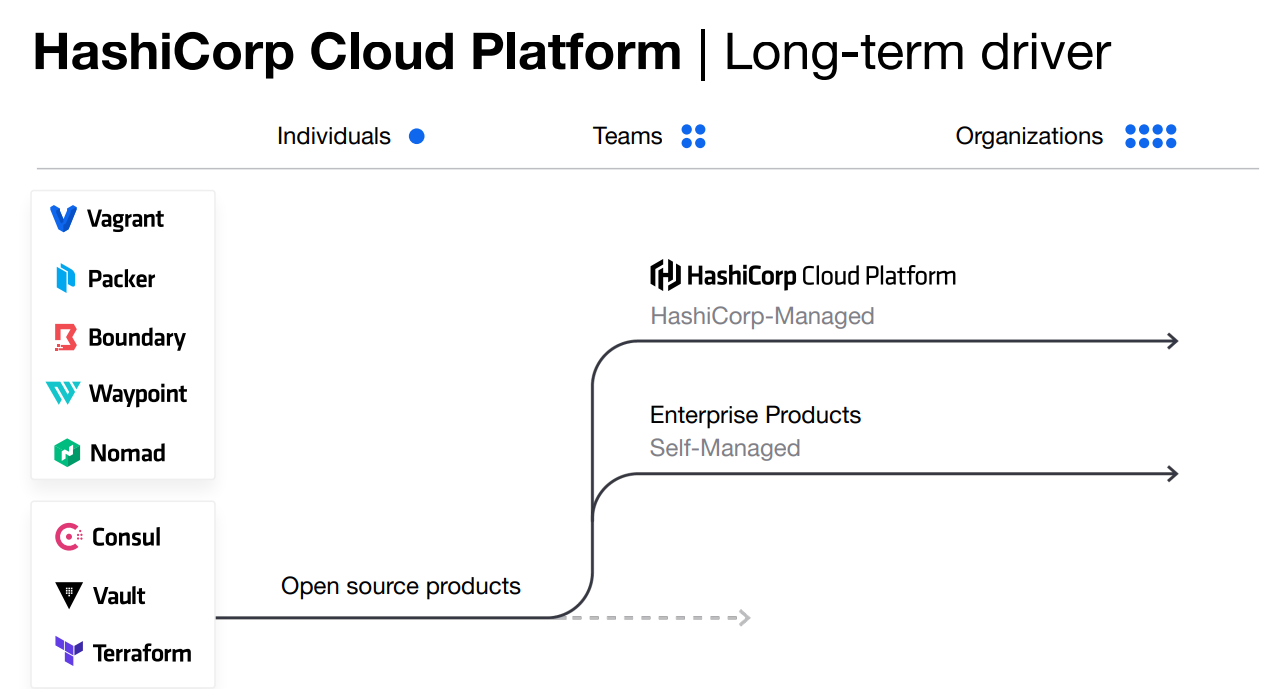
Source: Q4 FY22 Corporate Overview
At first glance, it looks like this growing cloud infrastructure firm is biting off way more than it can chew. Seriously, four different levels of cloud computing, all at once?
As you probably expect, there’s a method to the madness. One that takes the power of product-led growth in the SaaS vertical and extends it to leverage awareness surrounding the different layers of cloud computing.
Product(s)-Led Growth Flywheel
HashiCorp pluralizes product-led growth with open-source, free offerings for numerous products. Its product(s)-led growth. Eight distinct tools, all related to HashiCorp’s overarching goal of “unlocking the cloud operating model.”
In other words, they are looking to provide enterprise IT with tools to make their foray into cloud a success. Here’s how they look to drive this growth in a sustainable way:
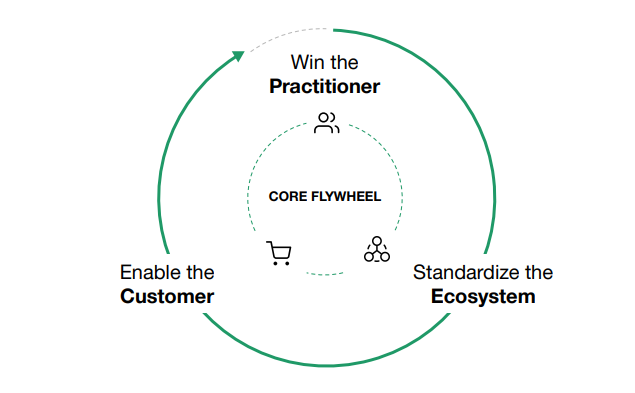
Source: Q4 FY22 Corporate Overview
HashiCorp has three open-source offerings that kick off their “core flywheel” and bring new developers, operations, security, and networking users into the fold. These products are Terraform, Consul, and Vault.
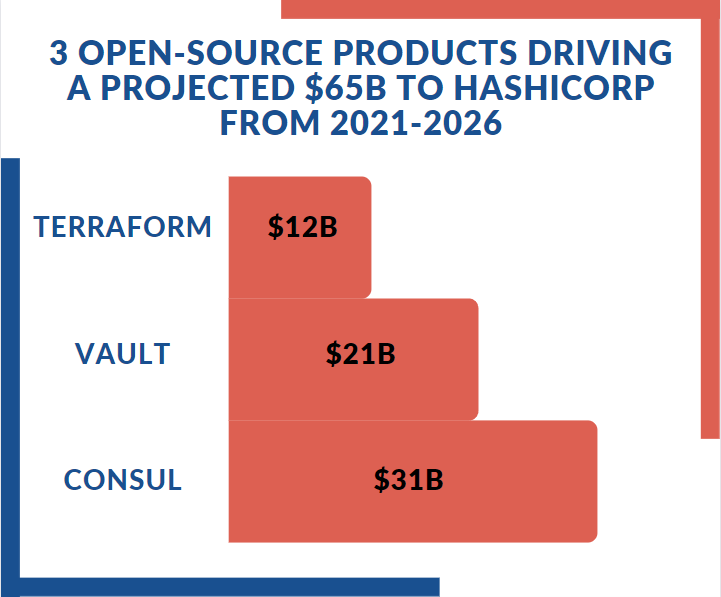
Terraform: HashiCorp’s Infrastructure as Code
One of HashiCorp’s most important product offerings, Terraform is an open-source tool that allows companies to define what they want their infrastructure to look like and then automate it as a day-to-day workflow.
Consul: HashiCorp’s Service Networking Solution
Consul is a tool that allows multi-cloud companies to automate service networking. It allows organizations to securely connect the various applications running across their cloud environments.
Vault: HashiCorp’s Secret Management Solution
One of the major tradeoffs for the efficiency and power of multi- and hybrid-cloud digital structures is reduced security. Authentication, access, and authorization are difficult to manage with such a large virtual footprint. Vault improves this by centralizing this information, providing fine-grained access control, and enhancing auditing capabilities.
Now, HashiCorp isn’t the first B2B SaaS company to offer a suite of products to entice its users.
Companies like Atlassian, Salesforce, and HubSpot all take a similar approach to growth (though, not in the cloud infrastructure market). What’s interesting is how HashiCorp chose to position these products as microbrands with distinct sites.
Between Terraform, Consul, and Vault, HashiCorp created a network of sites and channels that feed into one another, which has interesting implications for them from an SEO, CRO, and community-building perspective.
How SEO & CRO Drive Open-Source Adoption
Here’s the search scorecard for the HashiCorp parent site:
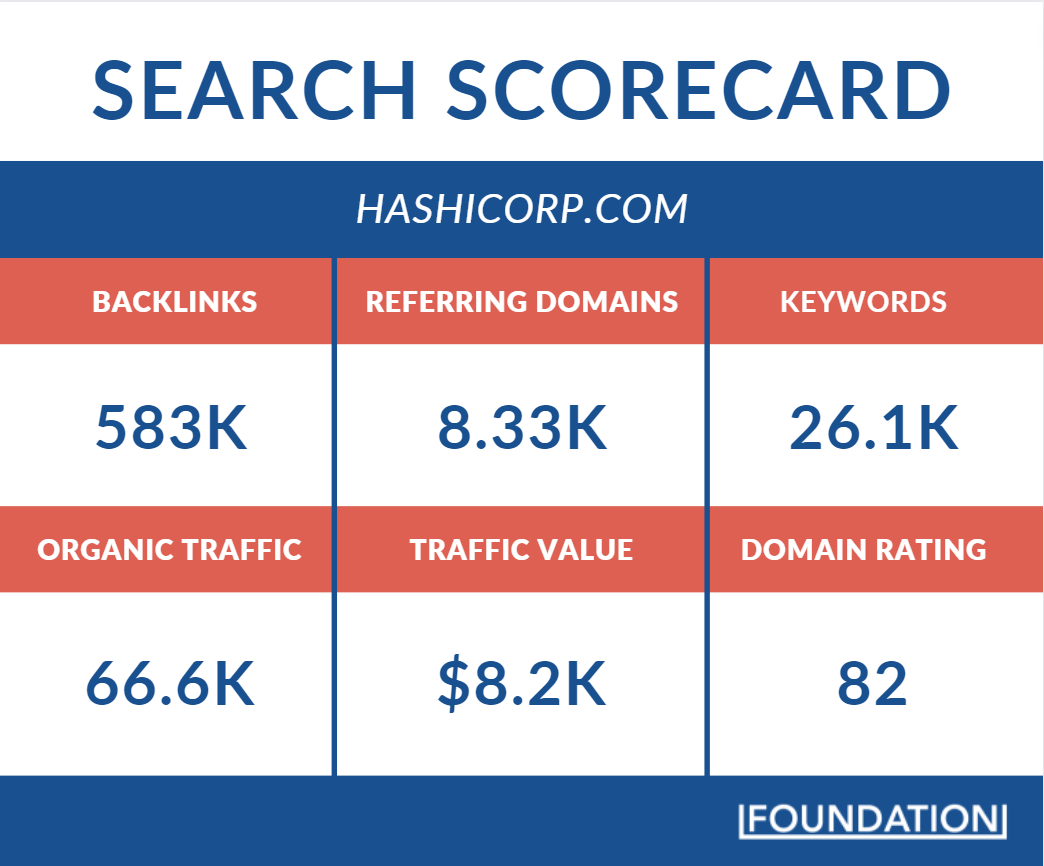
On its own, this isn’t really anything to write home about (at least not in comparison to the SaaS brands we usually cover with these analyses). Because they’ve adopted an approach that prioritizes product-led growth over traditional sales and marketing, you might assume they have good social engagement on technical social platforms and referrals from GitHub. Both are true, but organic traffic is actually their most popular marketing channel.
HashiCorp’s low search and traffic value numbers result from its decision to segment its product marketing efforts to match product offerings. Terraform, Vault, Consul, and the rest of its products each have a dedicated website that provides immediate value and removes the need for marketing fluff. Visitors to these sites are looking for a specific cloud solution and HashiCorp provides pure value by removing all other distractions.
This singular focus is also incredibly helpful for building out their marketing moat across the different cloud layers. Product pages become stand-alone sites that are hubs for keywords, backlinks, and organic traffic.
Take a quick look at the terraform.io scorecard and compare it to the HashiCorp one listed above:
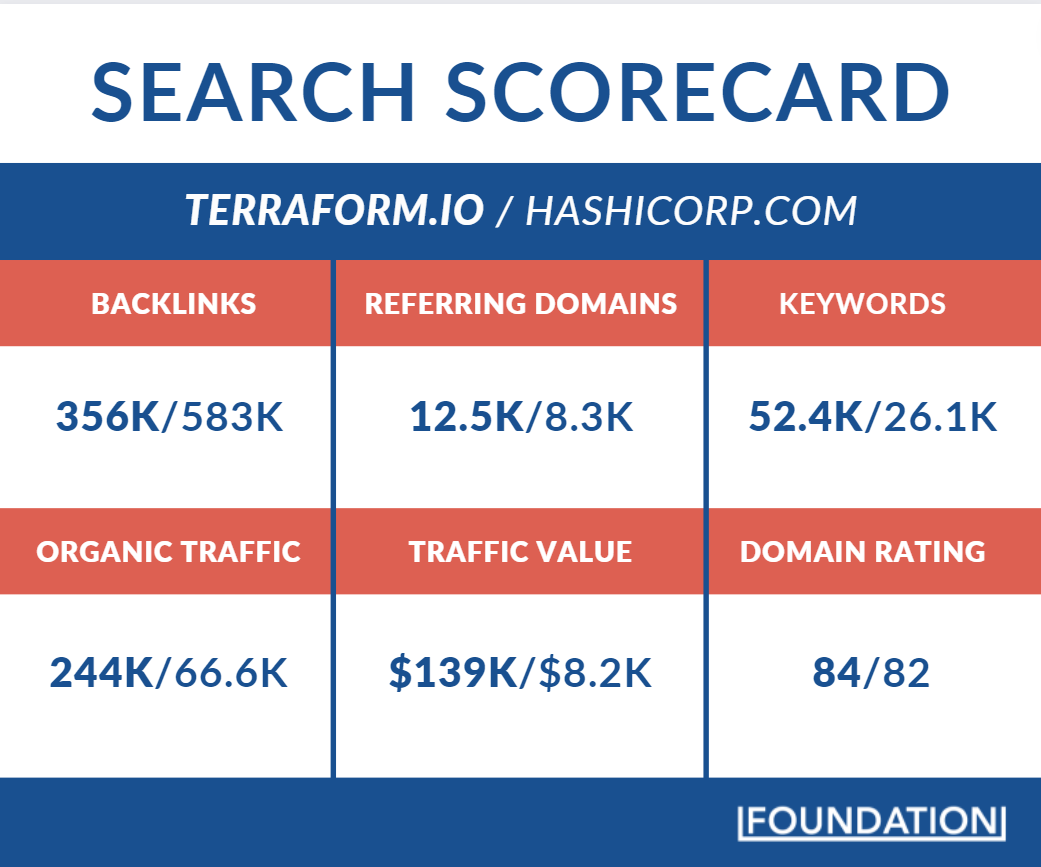
Here’s what stands out to me:
- Higher URL and domain rank
- Thousands more referring domains
- Double the amount of keywords
- 4x the amount of organic traffic
- Traffic that is 17x more valuable
While Terraform is the best-performing example of this strategy in action, HashiCorp is applying it across its entire product suite. Again, it’s products-led growth. From infrastructure to security, HashiCorp spreads its bottom-of-the-funnel content throughout the web in a way that reduces friction for its developer end users.
The strategy is definitely working. According to HashiCorp, Terraform has over 100-million downloads since its first release. A quick look at the terraform.io home page gives us a glimpse of how marketing efforts are keeping the conversion rates so high for this product:
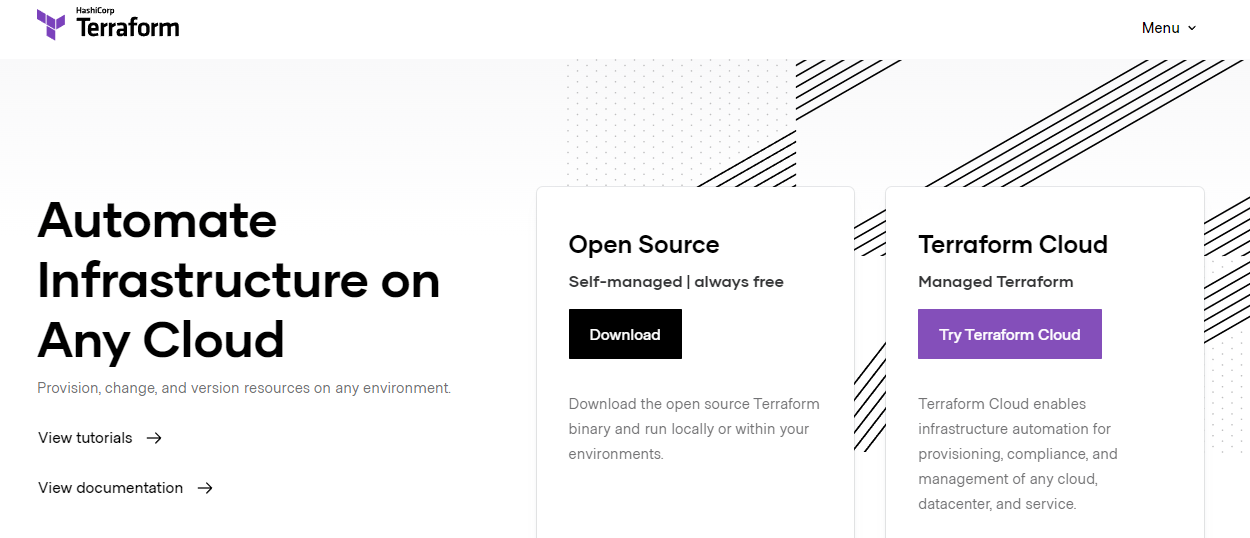
Source: terrafom.io
No long-winded marketing spiel. No over-the-top graphics. No hitting up visitors for information. Just 4 CTAs that direct visitors towards immediate value:
- A link to Terraform’s open source download
- A CTA for HashiCorp’s managed Terraform Cloud
- A link to the Terraform tutorials page
- A link to the Terraform documentation
This straight-shooting homepage is a great way to get infrastructure operators to adopt Terraform as their solution. Ditto for Consul, Vault, and Nomad for the rest of the cloud IT crew. These stand-alone sites are a starting point for the “win the customer” stage of HashiCorp’s growth flywheel.
From there, it’s all about building a community of developers that will land HashiCorp institutional customers where they can further expand and extend their product offering.
Community-Building Through Gitlab
Developers are one of those user bases that give marketing departments a difficult time. They generally distrust sales-y marketing efforts and don’t have time for BS. Product-led growth strategies certainly help keep marketing teams in check by hyper-focusing their messaging toward the end-user, but it’s still a difficult task. Here’s how HashiCorp CMO, Marc Holmes, looks at the situation:
“There’s always a conversation, developers don’t like marketing. That’s not true. They don’t like BS, and so if you don’t feed them BS, it’s fine. They like to be told what things do and why we think that matters to you, and they’ll make up their own minds.
That’s true throughout all kinds of developer marketing, whether it’s community activity or commercial activity. Tell them what things you do. Be rational about that. They will make up their own minds and that gives you a lot more strength than trying to sell to them or try to blind them with BS for sure.”
As you can probably guess, Marc cut his teeth as a developer. Much like the product-led model itself, he gained his experience from the bottom-up before entering the world of high-level developer marketing. He’s been a lead developer, a developer relations manager, head of growth marketing, and is now leading all of HashiCorps’s marketing efforts.
He sees first-hand how crucial community-building is to catalyzing growth for more technical B2B SaaS brands. You don’t get more technical than the cloud computing space. The problems that developer, operations, security, and networking pros face are incredibly difficult to articulate without the proper background. It takes more than just internal product-led alignment to understand these issues.
Market segmentation via multiple product offerings helps the HashiCorp developer relations team interact with their end users on a more granular level. They can identify where they are winning, where they need to make improvements, and which products are driving the most growth. GitHub is an invaluable tool in this sense.
Here’s how end users are currently segmented by HashiCorp’s product suite:
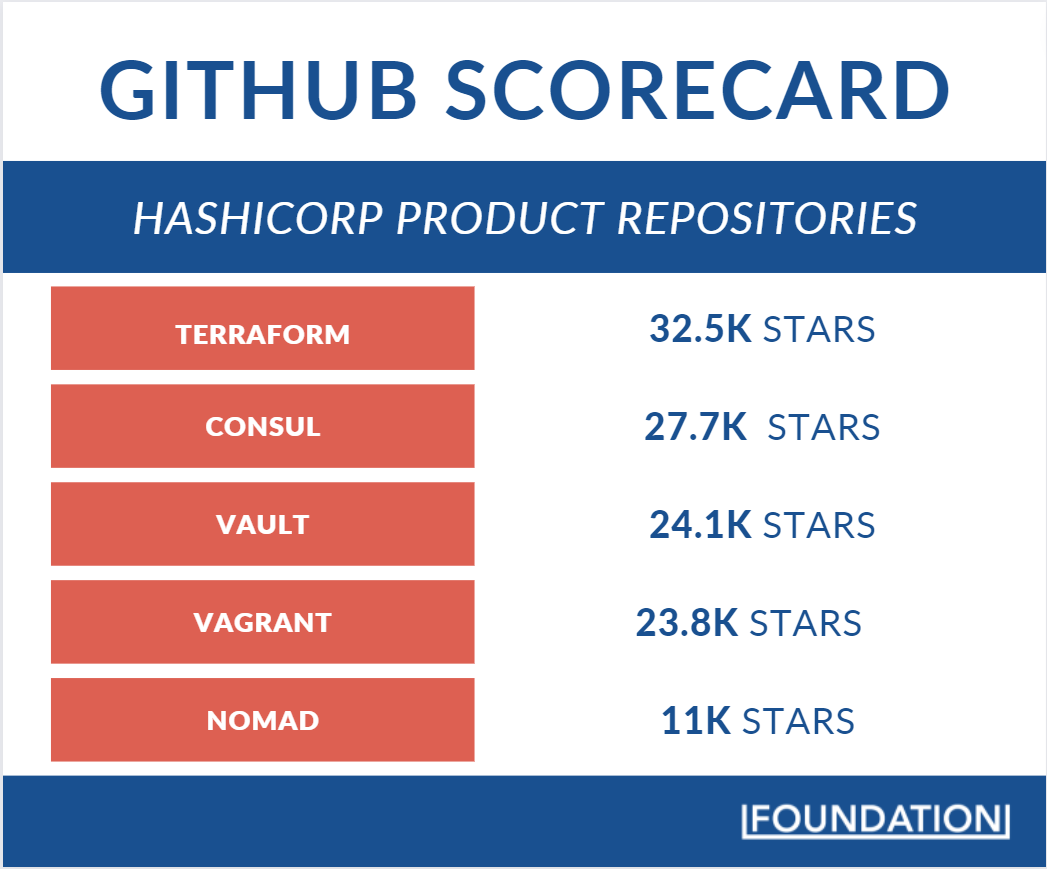
And here’s how the Big Three of Terraform, Vault, and Consol have grown over the past eight years to help HashiCorp “Win the Practitioner:”
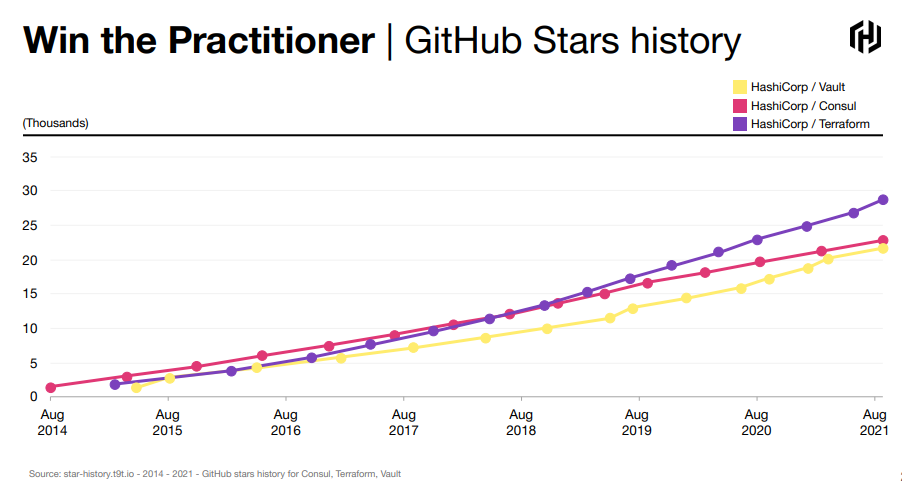
Source: Q4 FY22 Corporate Overview
But winning these different IT practitioners isn’t the end game—it’s just the start. Millions of monthly average users on open source products won’t pay the bills long term. You need to build commercial success out of that community.
Expand and Extend: Building Commercial Success Out of Community
So far, we’ve talked about how HashiCorp positions their core products of Terraform, Vault, and Consul to create multiple SEO/CRO moats that, when combined with their superior products, help them adopt various cloud developers and land enterprise teams.
This strategy helps get their products in front of their various end users quickly, reduces the friction created by exposure to unnecessary marketing materials, and provides multiple community hubs.
But, as you can see below, these are just the first two stages of their products-led growth strategy:
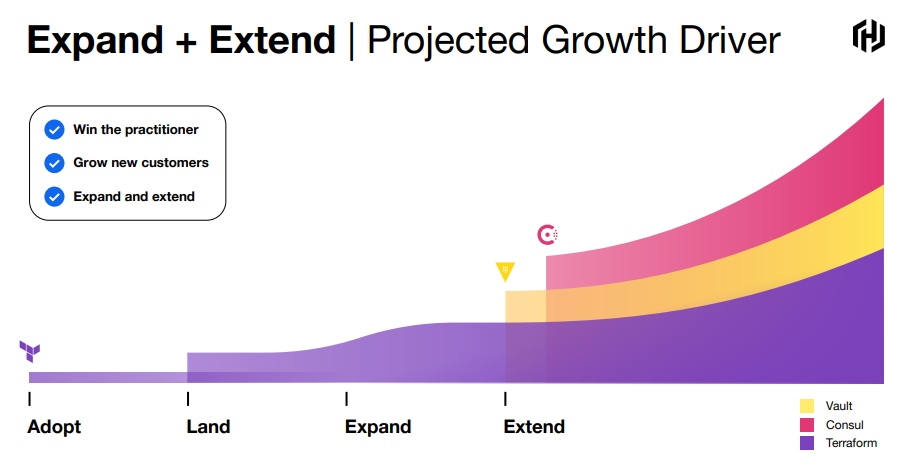
Source: Q4 FY22 Corporate Overview
HashiCorp knows that Terraform is one of their most popular open-source products. It functions at the bottom of the cloud layer-cake and can provide enterprise teams with immediate value in terms of infrastructure. But they also know that there are numerous issues at the security, networking, and platform layer where their products provide even more value.
Moving from open source to commercial scale necessitates a further adoption of HashiCorp products like Vault and Consul. Once they’ve landed an SME or enterprise team on one of these tools, they can monetize by 1) expanding the scale of product use and 2) extending into another product from the HashiCorp stack.
The final form of their growth driver is the HashiCorp Cloud Platform.
It’s a completely managed service stack including Terraform, Vault, Consul, and Nomad. By taking over responsibility for running the lower cloud layers, HashiCorp “automates the cloud” for their enterprise clients. With cloud infrastructure concerns off the table, these clients can now focus more resources and capital on their own SaaS offerings.
So, having won the practitioner and standardized the cloud infrastructure ecosystem, HashiCorp’s multi-product approach now enables their enterprise customers to focus more heavily on creating value and less on managing the complex layers of cloud computing.
The proof is in the pudding. Here are the quarterly numbers of HCP over the past two years:
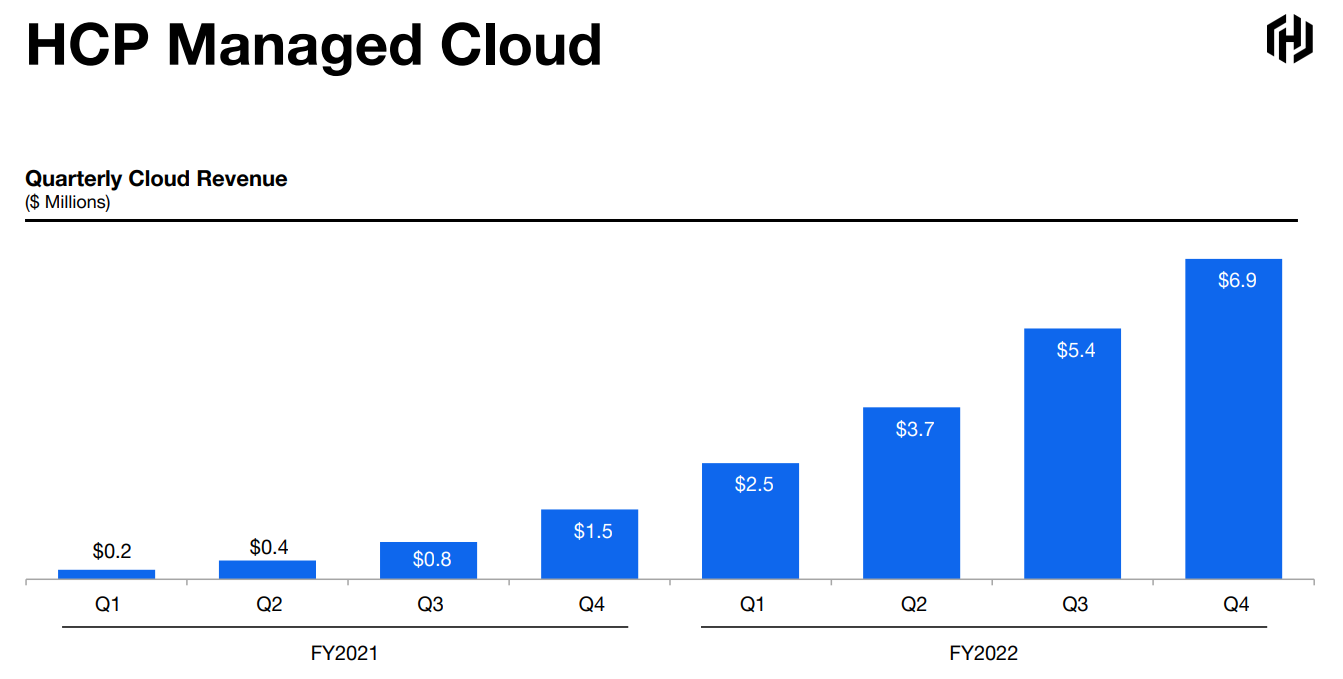
Source: Q4 FY22 Corporate Overview
This explosive growth is the culmination of HashiCorp’s ten-year focus on creating products that perfectly meet the needs of cloud developer, operations, security, and networking professionals.
To recap, here’s how they did it:
- Apply the product-led approach across all cloud computing layers, targeting multiple IT professionals.
- Winning over these professionals with open-source products that have been developed meticulously with buy-in across all departments.
- Driving product adoption by creating stand-alone sites with immediate CTA’s for product downloads, documentation, tutorials, and managed services.
- Leveraging developer community segments to land enterprise teams and entire organizations.
- Expanding and extending enterprise accounts into other core products through open-sourcing and gating product scale.
The divide and conquer approach to multi-product-led growth may not be applicable for all B2B SaaS niches. But for the cloud computing industry, where the total accessible market spreads vertically and horizontally, it’s clearly a play that the C-Suite needs to consider.
Quick, do it now before the next drop!








